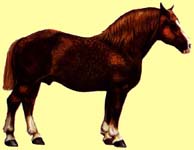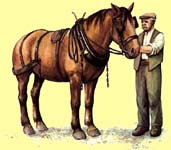|
|
The Breton |
|
|
The Breton |
 The Breton, from the Brittany region of France, is a horse of the brachymorphic type. The origins of the Breton, according to some sources, date back at least 4000 years to when it was brought into Asia by emigrants from Asia, the Aryans. Others believe that it stems from the smaller horses which were bred and improved by Celtic warriors on the heartland and slopes of the Massif Armorique, before they began their conquest of England. The Middle Ages was probably the most glorious period in the lost history of this horse, when it was particularly sought after by military leaders for its alluring and comfortable gait. This gait is halfway between a brisk trot and an amble, and because of the gait, the breed became known as the Bidet d'Allure or Bidet Breton. The Bidet Breton measured about 14 hands high at the withers.
The Breton, from the Brittany region of France, is a horse of the brachymorphic type. The origins of the Breton, according to some sources, date back at least 4000 years to when it was brought into Asia by emigrants from Asia, the Aryans. Others believe that it stems from the smaller horses which were bred and improved by Celtic warriors on the heartland and slopes of the Massif Armorique, before they began their conquest of England. The Middle Ages was probably the most glorious period in the lost history of this horse, when it was particularly sought after by military leaders for its alluring and comfortable gait. This gait is halfway between a brisk trot and an amble, and because of the gait, the breed became known as the Bidet d'Allure or Bidet Breton. The Bidet Breton measured about 14 hands high at the withers.
The Breton has been influenced by blood received from horse which were brought back from the Holy Land by Crusaders. Later in the Middle Ages, there were two types of horses which developed in Brittany. The heavier one was known as the "Sommier" and it was used as a pack horse. The lighter horse was called the "Roussin" and it was used in wars and for long journeys. After the Middle Ages, these two types were crossed with other French heavy breeds until 1880. At one time, four deviations of the Breton existed, the other two being amblers or pacers. The riding type, the "Roussin," was also known as the "Cheval de Corlay," and it was even raced at local meetings.
During the development of the breed, the Norfolk Roadster and its descendant, the Hackney Trotter, were introduced into the breeding of the Bretons, thus developing the Postier-Breton. The Postier-Breton (also referred to as the Breton Postier) was called such because it was used for drawing mail coaches. It is far more active than the Grand Breton (or Breton Heavy Draft), and it is almost clean-legged. A lighter version of the Suffolk Punch, it was once the pride of the French Horse Artillery. It is ideal for light draft and farm work. As the result of contributions from the Boulonnais and Percheron, both sharing the powerful Norfolk Roadster in their ancestry, the Postier inherited the exceptional energy at the trot. These Breton Postiers have shared the same stud book with the heavy draft since 1926, and they are selectively bred. The Positer is required to pass various performance tests under harness at traditional events on festival days. Still popular in France, it is now exported to North Africa, Japan, Spain, and Italy for use in improving the local stock.
 The Breton Heavy Draft is massive and early-maturing, and it is a much sought after horse in the meat market. Also known as the Grand Breton, it received contributions from the
Ardennais, the
Percheron, and the
Boulonnais, and today is has been practically reabsorbed by the medium size form. This medium-sized Breton is now called the Fast Heavy Draft Breton. The lightest form of the Breton is the Corlay, which is used as a riding horse and for light, fast draft work. Today, the Corlay has almost disappeared, and it is now recognized by some people.
The Breton Heavy Draft is massive and early-maturing, and it is a much sought after horse in the meat market. Also known as the Grand Breton, it received contributions from the
Ardennais, the
Percheron, and the
Boulonnais, and today is has been practically reabsorbed by the medium size form. This medium-sized Breton is now called the Fast Heavy Draft Breton. The lightest form of the Breton is the Corlay, which is used as a riding horse and for light, fast draft work. Today, the Corlay has almost disappeared, and it is now recognized by some people.
The Breton is controlled as a breed by the Syndicat des Éleveurs de Cheval Breton. The Stud Book dates back to 1909, and only horses born in the four departments of Brittany, and in the Loire-Atlantique can be entered into the Stud Book. All registered foals are branded with the distinctive mark of the breed, a cross surmounting a splayed upturned V, on the left side of the neck. The Breton once was used to improve other heavy draft breeds.
The Breton has an aptitude for heavy draft and farm work with a long endurance quality. Its temperament is energetic and lively. Today the Breton is distributed in Europe and Japan and is of international importance. The Breton is a quick, active horse which is suitable to all sorts of agricultural work, and it is also extensively employed in the French vineyards of the Midi. The Breton is active, fast and free at the walk and at the trot. Due to its hardiness, strength and stamina, the Breton is well suited as an outcross for improving less well-developed stock.
The Breton stands 15 to 16 hands high at the withers, and weighs 1,540 to 1,980 pounds. There are three distinct morphological types - the Grand Breton, the medium or Postier-Breton, and the Corlay. The Breton's coat is usually red roan or chestnut in color, but bays, greys, and other roans also occur. Its head is well-proportioned and square, although the jaws are heavy. The profile is straight or slightly snub. It has a broad forehead, short ears, and large, open (flared) nostrils. It has bright and kindly eyes, and its rather small, mobile ears are set rather low on the head. The broad and muscular neck is arched, quite short and well set-on. The sloping shoulders are somewhat shorter than what might be expected in a draft breed. The broad muscular withers are not pronounced, and the back is short and straight. It has an attractively short and square outline, with a strong, broad and deep body and powerful quarters. It has broad loins and sloping, full, muscular quarters. It has well-muscled forearm and shin, and the cannons sometimes are slender but solid. It has short, pasterns which carry little or no feather, and the hoof is strong, well-formed and not too large. The tail, like that of the Norman Cob, is customarily docked, which is thought to give the horse a more jaunty appearance. Docking the tail prevents the rein from becoming caught up under the it.
For more information on the Breton draft, visit:

|
© 1997-2007
NW Breyer Horse Club & Refiner of Gold Creations Equinealities in place since 1997, Section in place 2001, Updated 3/13/2007 |



|
| ||

|
|||||